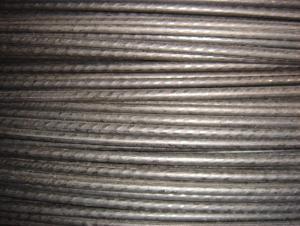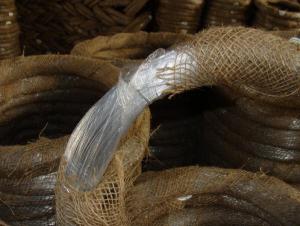Hot dipped galvanized wire
- Loading Port:
- China Main Port
- Payment Terms:
- TT OR LC
- Min Order Qty:
- -
- Supply Capability:
- -
OKorder Service Pledge
OKorder Financial Service
You Might Also Like
| |||||||||||||||||||||||||||||||||||||||||||||||||||||||||||||||||||||||||||||||||||||||||||||||||||||||
- Q: How much wire is required?
- Length of wire is L = R*A/p SI units must be used, so convert radius of 1/64in to meters: r = 0.0254 / 64 m (using 25.4mm = 1 inch) r = 3.969*10^-4 m (0.3969mm) So cross-sectional area is A = pi*(3.969*10^-4)^2 m^2 A = 4.95*10^-7 m^2 The average resistivity of nichrome is p = 1.1*10^-6 ohm-meter So the required length of wire is L = 2.2 ohm * 4.95*10^-7 m^2 / 1.1*10^-6 ohm-meter L = 0.990 m
- Q: I have a 5 pin ignition. I have Black and red wire coming from behind the starter.Yellow wire on the other side of the engine that is connected to the magnet by the fly wheel.Where do I put these wires in the ignition switch. ____ ____ __
- You need to hook three wires into a five terminal switch? You aren't helping us much with any usable information. The yellow wire is the kill wire from the magneto. The black and red wires are hot from the battery and feed to the starter solenoid, assuming the switch has a start position. You need to check each terminal on the switch with an ohm meter to determine which function it serves and test the black and red wires with a volt meter to determine which one is hot now. Better still, why don't you specify the make and model, even the serial number if you can get it, and ask if anyone, including your local dealer, has a wiring diagram for that particular machine.
- Q: where does the expression 'down to the wire', come from?
- I found this online: The wire is used in a four-legged footrace-- at least I've only ever heard the word tape used for races involving bipeds. That and ribbon. The wire in question is an actual wire, and it's used in the Sport of Kings, horseracing. A tape or ribbon would be too stretchy to instantaneously trip the shutter on the finishing-line camera when it was crossed. A horse has no problem busting through a single strand of wire.
- Q: Our house ground wire is very long but our live and natural wires are very short. Once there was a surge in our telephone line system and both my Belkin Surge Protectors seemed to have not stopped it. The surge was stopped at my last protector when its sensitive fuse blew (it was a 10 ohm resistor fuse). Is it possible that since the natural wire is shorter than the ground wire the surge wantted to go through my PC and into the natural wire? Or is it just because the 10 ohm resistor fuse was a bit too sensitive or something? (Well it didn't blow up when there was no lightning outside)I'm thinking of making my natural wire longer by extending it so a surge finds the ground wire more attractive, is this advice able?
- Check and make sure its grounded properly,if your in a high surge area look into a surge meter from your electricity company.Peace of mind,no need for buying surge protectors and wishing they work.Any lose will be insured by electric company.
- Q: the plug only has room for black,red,ground wire.. what do i do with the white wire
- You can't. You need a 4-wire receptacle to use with 4-wire cable. That is the only to wire this circuit to code. You will need to replace the cord on your appliance with a 4-wire as well.
- Q: i am hooking up a wiring harness on a 2000 ford ranger and cant figure out the wires to hook up and what they are
- What kind of connector? How many wires? There are several different types of trailer plus out there. The most common is the four wire flat connector. The wiring for those is: yellow = left turn/brake green = right turn/brake brown = taillights white = ground Easy way to remember that is that green and right both have an R in it, as in Right turn. Yellow and left both have an L in it as in Left turn. There are also 6 wire round connectors and 7 wire round connectors. Totally different wiring for those.
- Q: Hi,I'm trying to install a ceiling light with a 3 wire configuration (white, black, ground) into a wire configuration of 4 wires (white, red, black, ground). This is configured for two on/off switches.So far, I have white to white, black to black, and ground to ground with the red capped off. This works with one switch perfectly, however when I hit the other switch, the circuit breaker blows.Please help, and thank you!
- I think according to your description of the wire configuration what you have is a power supply at the switches and 2 lead wires (red and black) coming up to power the light and fan separately. The white wire, or neutral wire is for a return path while the ground wire is a backup in the event the neutral fails.At the switch in the wall, you should note a black wire (power source) coming to the bottom terminal of any switches. From there, you will find another black or red wire going to the light itself. The neutral wires are all connected together and tucked away in the switch box. If the 4 wire configuration is from the fixture itself, then you would have a black wire for power to the light, a red wire for power to the fan unit while the white is a neutral return. If there is only one wall switch, you could in theory, connect the black and red from the fixture to the power supply coming up from the switch and therefore use the pull chains located on the fixture to turn on the light or fan or both. Failing this, it would be best to call a qualified electrician and protect yourself from what could be a nasty fire. Good Luck.
- Q: for california electrical code, am i limited to insert no more than one wire per knockout on a box ?
- no. the number of wires in the box is restricted based on the volume of the box but the number of wires entering a knock out is restricted by the size of the conduit or the cable type connected to the knock out.
- Q: i want electrical symbol used in house wiring
- If an you are living in the UK try BS 7671- Formerly the Wiring Regulations. More symbols than you can shake a stick at. Try OKorder for an old copy, the symbols rarely change.
- Q: Okay so my question is how would I wire these in a ported box with 2 terminals on each side of the box? Also, is the quot;Bridged Wirefeatured in the diagram negative speaker wire? Thanks.
- Bridging isn't something you do with the subs wiring. It's the way you wire them on the terminals. Each amp's manual should tell you which terminals are the bridgeable ones. That's a mono amp. There's not much you can do there with bridging etc..Try looking for a 2 channel bridgeable amp and then worry about wiring the subs. Not sure why you would want two terminals on both sides of the box anyway.
Send your message to us
Hot dipped galvanized wire
- Loading Port:
- China Main Port
- Payment Terms:
- TT OR LC
- Min Order Qty:
- -
- Supply Capability:
- -
OKorder Service Pledge
OKorder Financial Service
Similar products
Hot products
Hot Searches



























